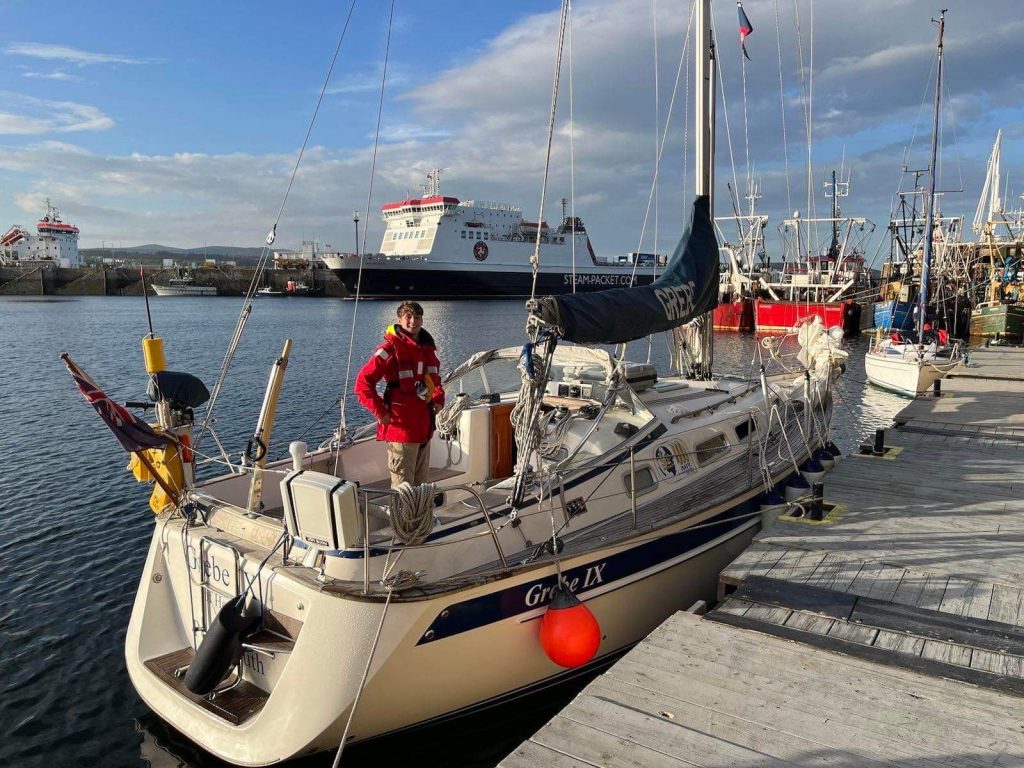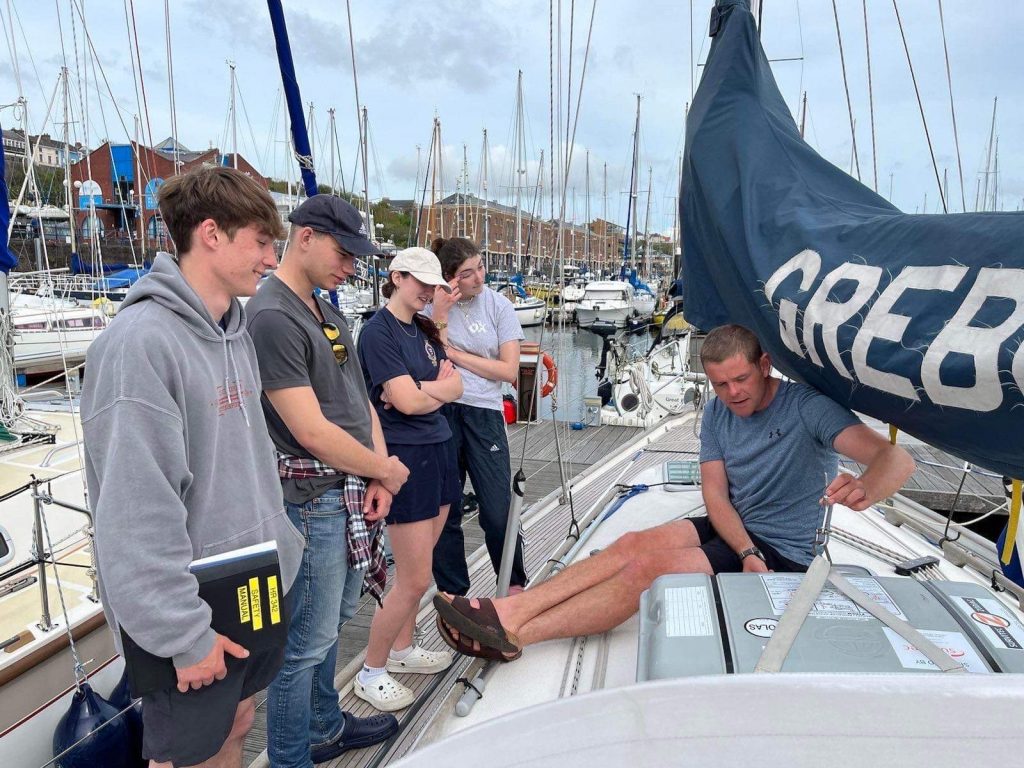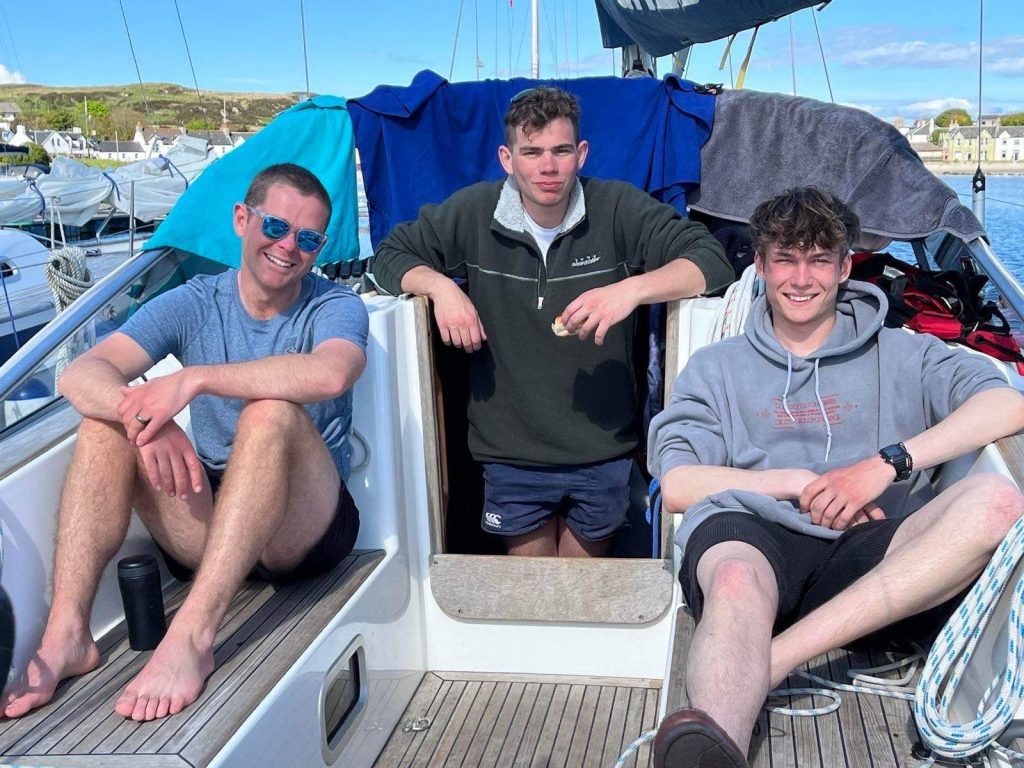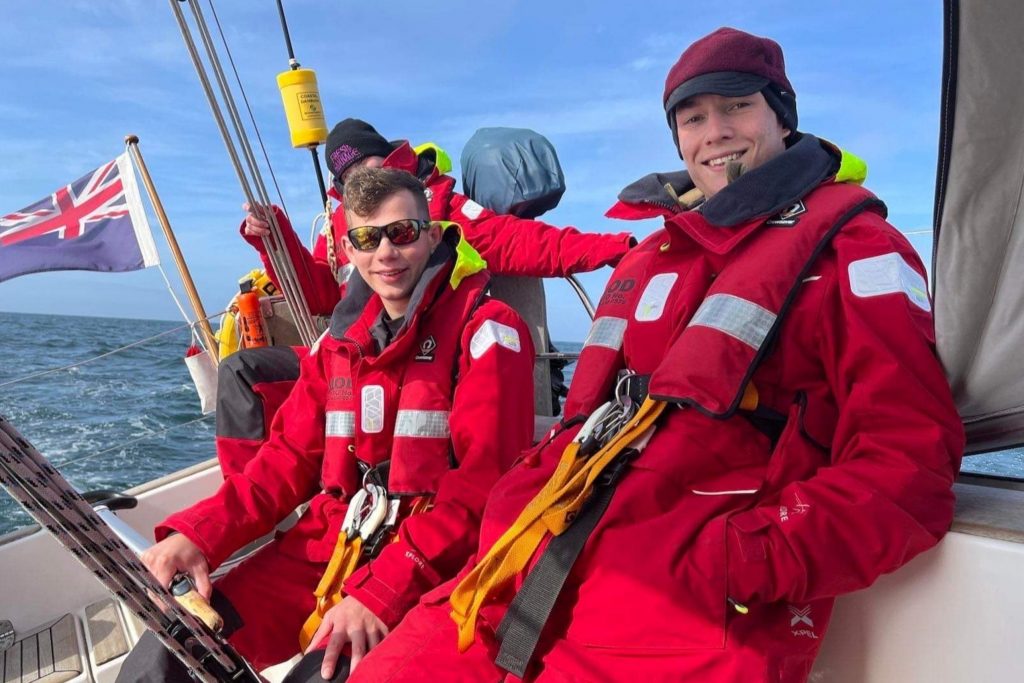Seven Officer Cadets from Oxford University Officer Training Corps (UOTC) recently undertook a challenging sailing expedition from Gosport to Dunstaffnage in Scotland. Alongside a sister boat with Officer Cadets from Exeter UOTC we conducted an extremely rewarding trip, consisting of over 850 miles of vigorous sailing with many hours spent sailing at night and overcoming challenging conditions. The following is a summary of each leg and a report of our activities:
Leg 1 – Alpha
We began the week by meeting the boat at Joint Services Adventurous Sailing Training Centre on the 28th April. After provisioning and taking the crew around the boat we set sail into the Solent on the 29th for a day of training, as 3 of the crew had never sailed before. On the 30th, with the crew feeling jubilant for the week to come, we set off to our first stop of Weymouth. A successful first day ended at anchor just off Portland Bay and a well-rewarded, although quite fresh, swim off the back of the boat. The next day started off well with consistent wind, however a complete lull in wind and an engine that refused to start meant the entire afternoon was spent slowly drifting towards Dartmouth. As it started to get dark we decided to divert to a different port and come alongside a pontoon in the small fishing harbour of Brixham. Without an engine this had to be conducted under sail, something not typically permitted in Brixham due to a local byelaw (we radioed and received an exemption in advance of entering the marina) and rarely undertaken in anger due to the higher risks involved compared with parking in a marina under engine, however under excellent guidance from 2Lt Zack Coleman, with Pirates of the Caribbean as a theme tune, and with a crew who by now were feeling very confident using clear communication we achieved this without any drama. There was a slow start to day 4 as we waited for the mechanic to fix our engine before we could continue. Once fixed at 13:00 we had the challenge of catching up to the Exeter boat who had left us and continued to Dartmouth. A late start meant we had our first night sail of the trip. This was conducted with 2 x3 men watches and a 3 hour on 3 hour off rotation. With this in place we arrived into Falmouth at 04:30 on the 3rd under strong winds and once moored up we rewarded our selves with tea all round (this would become quite the tradition and almost a constant necessity). The 3rd was a well-deserved rest day and allowed all cadets, both Exeter and Oxfords’, to catch up on university work. In the evening both OTCs spent the night bonding, sharing stories and getting to know each other better. Falmouth to Newlyn was a simple sail and a relatively short hop that would set us in a good position to round Lands End and set off to Milford Haven the next day. As we set off on day 7 for what would be our final and longest sail of the first week the wind was strong and the sun was out. It was an amazing sail past Lizard Point and the views were outstanding. They were only to get better in the second week.

Leg 2 – Bravo
The new crew joined us in Milford Haven on the 7th and after a brief introduction to the boat we set off on the 8th towards the Isle of Man. For the new crew this was quite a daunting challenge as it was over 150 miles and 36hrs long. To make matters worse we had the roughest sea state of the entire journey and extremely dense fog for the first 5 hours. This was probably the most challenging start the new crew could have had and although they suffered from it, all kept in good spirits and pulled through with the promise that it could only get better from here. Thankfully the water calmed down for the night watches, so at least what little sleep we did get was not interrupted by being rolled off your bunk and only by the constant rumble of the engine.
Once we made it to the Isle of Man (IoM), we were able to recharge and restock and then prepare for a very quick turn around with the knowledge that we would be leaving at 04:30 in order to avoid fighting the tide around the top of IoM. Sadly, a stiff inshore tide not displayed in the tidal atlas meant that we ended up fighting about 1-2 knots of tide for the entirety of the next passage, which, when you have a max speed of 7kns with good strong winds made the going quite tough.
With the crew now already experts in 3hr on 3hr off watches the passage was relatively easy with a breakfast of sausages, bacon, eggs and toast being cooked by Holland and Lloyd being a particular highlight and a very welcoming thing to wake up to. We only ran into our first issue on this passage on the evening of the 10th once we were only 5 miles out from Bangor a message came over the VHF from PETREL (Exeter’s Boat), who were 10 miles behind us, saying that their engine had stopped working and that we were to turn around and prepare a tow line. With the prospect of adding another 4 hours minimum in order to reach them and then tow them behind us, and knowing that they had left us the week prior when our engine broke, the crew’s mood was slightly deflated. Thankfully not for long however as PETREL managed to get the engine going and so we could continue.
For dinner in Bangor, we made loaded burgers on the boat and these were incredibly appreciated by everyone and along with an episode of Band of Brothers they were critical to keeping morale high after two very long passages and early mornings. Thanks to the tides however, the next day was to be much of the same with a 03:30 start, 3hrs on 3hrs off, and breakfast lunch and dinner underway. At least this time the tides were with us and combined with some nice downwind sailing that meant we were reaching speeds of 10knts.
Our destination was Port Ellen on Islay, a beautiful little town with amazing views and a good local pub. Before we got there, we thought that the light winds and protected waters a mile out would give a good opportunity for Holland, Lloyd and Davison to practice some simple sailing skills. A slight misunderstanding of the commands used in a tacking manoeuvre saw Davison ordering the girls, who were controlling the ropes for the front sail, to “let loose”, much to our amusement.
After spending an hour or so learning the ropes (literally) and understanding what each manoeuvre did for the boat we anchored off the marina and had for some their second swim of the trip but for most their first. The water was even colder than Portland although both Holland and Lloyd refused to be outdone by the challenge from the Exeter boat of the longest time spent in the water at 20 mins and spent a very admirable 25 minutes in.
We had a late start leaving Port Ellen in the morning due to fog and a change to our route to avoid the Sound of Islay meaning our plan to go to Tinker’s Hole was scuppered. We were making good progress there on our new route and even managed tea with jam and clotted cream scones for afternoon tea. We wondered if we had displeased some AT gods with this when less than an hour later, we found ourselves with 30ft of fishing rope wrapped around our propeller, no wind to sail and a rocky lee shore less than a mile away.
At this point it was very obvious to 2Lt Coleman that the only course of action he could take was to put his wetsuit on jump in with a knife to cut the yacht free, a job that I did not envy. On the first dive he was able to cut the yacht free and start sailing away from the lee shore, but noticed that GREBE would be unable to proceed by engine, because there remained fishing gear well wrapped up around the prop, which had the potential to cause real damage. Having assessed the problem, we alerted Exeter on PETREL, and waited for them to come over as they said they had a proper mask and snorkel, which would make it easier for Zack to finish the job. Once they reached us, they attempted to motor alongside and one of their crew was to throw them to us. Unfortunately, it wasn’t the most confident throw and after an awkward bounce off the deck they ended up in the water and then sank.

So, onward we sailed, to take the boat away from the lee shore danger and into a calmer sea state and with suitable depth where GREBE could drop the anchor and Zack could hop back in. Thanks to some great sail trimming and ultimate speed gaining techniques in very little wind, we were able to limp round to a safe anchorage where Zack was able to free the prop of the rest of the fishing line. In a nice bonus, the boat was surrounded by seals with one of the best views of the trip. Now dark, we decided that staying here was the better choice than carrying on for the night. The next day we were off to Tobermory (some may recognise the seafront from Balamory), with a morning sail that included an amazing cloud inversion with the Paps of Jura rising out of the cloud making for some atmospheric views.
Our final day of sailing was from Tobermory to Dunstaffnage, this was some of the most active sailing we had because the wind was the strongest, we had seen on the Bravo leg, in part due to the slight funnelling effect of the wind being channelled down the Sound. Also, the wind being directly behind us there was occasionally a risk of an uncontrolled gybe, but with a steady and competent hand from Millsop at the helm and expert sail control from Coleman we sailed it very nicely. We moored up for the final time in Dunstaffnage on the afternoon of the 14th, 350 teabags and 867 miles since departing Gosport. Naturally, we sat with a slice of cake, freshly made on the downwind sail, and began wondering where the winds might take us next year, but not before the 5 hours of boat cleaning that lay ahead of us!


